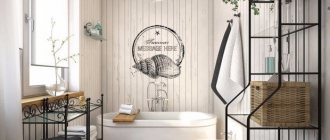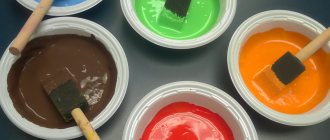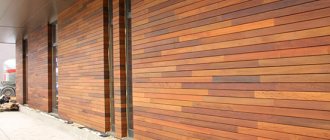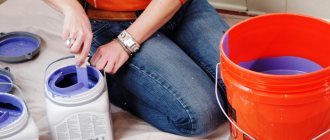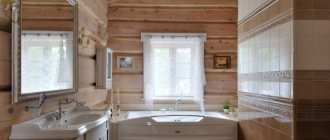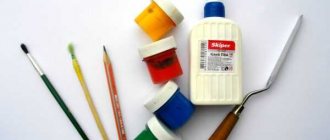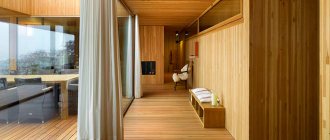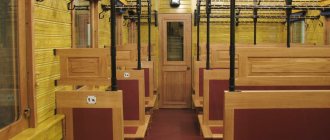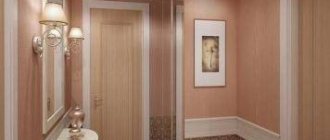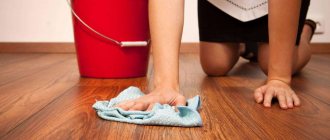Painted lining is rarely used in urban interiors; it is sometimes used as cladding for loggias or balconies. In private buildings, painted panels are used much more often, because they look very harmonious in country interiors. Varieties of this design will be discussed below.
Types of lining
Board cladding differs in the material of manufacture; finishing panels are also classified according to external qualities and connection options.
- Made of wood. Such boards are made from coniferous or deciduous trees: aspen, beech, ash, pine and others.
- Made of plastic. This variety is made from PVC materials by pressing molten plastic through a forming device. Extrusion allows you to give an object the desired shape.
- From MDF. Unlike the wooden type, the lining in this case is not planed from wood, but glued together from wood chips, due to which it obtains a high density. No harmful impurities are used in production.
- Made of aluminum. Cladding made from this material is only suitable for external cladding. Its advantages are light weight and anti-corrosion properties. The disadvantages are weak protection from physical impact and insignificant thermal insulation, so it is not used in finishing the interior of the house.
Depending on the quality of the material, the lining is divided into:
- High class, which is designated as “0” or “extra”. High-quality boards are not damaged; no wood core was used in their production.
- The lowest class, which is designated "C". Such elements may have 1-2 invisible knots, paint stains, and other defects.
Indoor lining: how to process it
You can paint the lining in different colors.
Some lovers of wooden structures believe that it is better not to treat the lining with anything, so that it has a natural appearance. In fact, everything is not so simple, since wood is not particularly resistant to external influences and quickly loses its attractive appearance. Regardless of where the wood is located - outdoors or indoors, it darkens, turns blue, etc.
To prevent this from happening, wood products have to be impregnated with protective compounds. In addition to the fact that wood loses some of its properties under the influence of air, moisture or sunlight, pests infest it and begin to destroy wooden structures from the inside.
The finishing with wooden materials is also covered because natural wood rarely fits into any style. In this case, you have to select both the color of the paint and its structure, which does not always work out.
All materials intended to protect wooden structures are divided into six groups:
- Protective compounds, both for external and internal work. Compositions for external use are distinguished by the presence of components that are resistant to ultraviolet radiation, which slow down the aging process of wood. If the balcony is decorated with wooden paneling and the balcony “looks” to the south or east, then a protective covering will definitely be required. The disadvantage of such compositions is that as a result of their use, the surface acquires a green or pink tint, since the protective composition reacts with the wood. Before using such compositions, it is better to carefully study the instructions.
Protective impregnations - Stains or tinting compounds. In their action, these compositions lead to the appearance of a peculiar shade on the surface of the wood. Their action does not lead to the appearance of a protective film on the surface, and the wood does not lose its properties, remaining vapor-permeable. These impregnating materials contain pigment. Depending on the pigment concentration, formulations can be lightly pigmented or highly pigmented. To control the degree of “painting” of the surface, it is better to use weakly pigmented compounds, applying layer by layer.
The result of stains of different colors - Lucky. Nowadays, water-based varnishes are very popular. Varnishes are produced, after opening the surfaces which produce glossy, semi-matte or matte surfaces. Many products allow you to add various dyes, which makes it possible to change the color of the surface. Water-based varnishes do not close the pores in the wood structure, which allows structures to breathe, while the surface is protected from dirt and dust. Some manufacturers add various components that protect the surface from UV rays, as well as antibacterial components. Similar compositions can be used to protect lining mounted on balconies, as well as in unheated rooms.
The varnish can be glossy, matte or semi-matte, or it can give color - pigmented - Paints , which are characterized by the fact that they create a reliable film on the surface, which, in turn, covers the structure of the wood. This group includes many materials made on various bases and also representing different price ranges.
- Wood protection oils, which are absorbed into the fibers without creating a protective film. Can be used as transparent compositions or with pigments. Their purpose is to protect the surface from dust and dirt. Such protective materials do not create a gloss on the surface, so the surface is matte, but pleasant to the touch. This is not a bad option for preserving wood products. With the help of oils, as well as the use of various pigments, it is possible to obtain a surface with a natural texture.
Brushing with wood oils - Wax-based compositions . There are three types of wax: solid, liquid and water. Solid wax is heated to a liquid state before use, while liquid and water wax do not require additional operations before application. Protecting wood with wax has been practiced for a long time and is highly effective. The use of modern technologies can significantly simplify the entire process. Unfortunately, wax cannot be applied evenly unless a layer of primer is applied to the surface first.
There are also combined formulations, so the division into groups is purely arbitrary. On the market you can find impregnations that can be tinted, as well as paints that have protective properties. Such compositions differ in their effectiveness of protection. Impregnations are aimed at protecting the wood, and the task of paints is to create a beautiful appearance of the surface. If it is necessary not only to protect the surface, but also to create an attractive appearance, then it is better to first use impregnation without tinting, and after complete drying, coat the surface with paint.
The use of oil and wax is another example of an integrated approach to protecting wooden surfaces. This approach allows you to increase the service life of wood products several times.
There are quite a lot of options; all that remains is to choose the most effective, practical and durable composition, based on your own wishes and capabilities.
Lining profiles
The appearance of the boards and the recesses for connecting them to each other determine the profile of the lining.
The most popular are:
- Eurolining. It looks like a long, narrow board with a groove and tongue on both sides. On the inside it has small gutters for ventilation. Panel width - from 10 cm, length - from 2 m, thickness - 1.2 cm.
- Blockhouse. Under this name lies a lining that imitates round logs; for this purpose, its outer side is made in the form of a semicircle. The profile has the following parameters: length from 2 to 5 meters, thickness - 3.6 cm, width depends on the thickness (9-19 cm). Coniferous trees are used to make boards.
- American. It looks like a wooden beam. The profile is made in the form of a rectangular trapezoid. The thick part, where the thickness is from 2.2 to 4 cm, has a groove, in the narrow part (from 1.4 to 2.8 cm) there is a tongue.
Painting the lining
Walls covered with simple clapboard are not suitable for all styles, so it is often necessary to paint the wooden boards in a color suitable for the interior.
The problem of painting is especially acute for owners of a country house, since this is where this cladding method is most often used.
Some people believe that there is no need to apply any compounds to the interior lining, but not in all conditions it will be able to maintain its appearance without them.
If ventilation is poor, the tree may turn blue, or in sunlight it may turn greyish. There are methods to combat these problems: blued boards are treated with agents containing oxygen or chlorine-containing compounds, and then covered with protective compounds.
Grayed wood is sanded to its original appearance, but without a coating the wood will soon turn gray again. Therefore, painting the boards immediately after installation would be the right decision.
Wood protection liquids are available in the form of:
- Protective compounds. Liquids for external treatment contain protection against UV radiation, which helps slow down the photoaging of wood and prevent the formation of a gray tint. Some of the protective liquids can, due to a chemical reaction, paint the wood with a bright color that only opaque paints can remove, so you need to carefully choose the impregnation.
- Toning substances. They create a light shade without overpowering the wood grain. A film does not form on top, and the wood does not lose its vapor-permeable properties. Stains contain different amounts of coloring matter, which is why they are weakly or highly pigmented. If you need to preserve the structure of the wood, it is better to choose a composition with a weak pigment, which will allow you to control the degree of visualization of the wood texture.
- Lakov. Water-based varnishes are popular and can be glossy, semi-matte or completely non-reflective. You can add color to some varnishes. Aqualaks form a vapor-permeable coating and also protect against contamination. Manufacturers add bactericidal components and filters that protect against UV rays. Aqualaks are suitable for balconies, country houses, baths.
- Paint. They form a dense coating through which the wood pattern is not visible. Paints are presented in a rich assortment; they come in conventional oil-based formulations, as well as more complex ones - latex and acrylate.
- Wood oils. They are produced transparent or with pigment. They do not form a film: wood fibers absorb oils well. Their effect is similar to that of varnishes: they protect against damage and prevent the penetration of dirt. Oils create a matte surface.
Solutions used for coloring
There are many means for covering lining. These are compositions for internal and external cladding of premises. They differ in composition, speed and quality characteristics. For example, a wooden exterior façade is affected by ultraviolet rays, moisture, high and low temperatures, so the finishing coating should contain the predominant majority of protective components.
You can decorate the lining of the interior of the house with ordinary enamels and paints. Painted natural boards have an original appearance. Each mixture after painting gives a certain effect to standard lining. The choice of solution depends on the preferences of the owner of a country or city building.
Protective agents: properties and application technology
Proper and timely use of protective equipment allows natural lining not to lose its appearance and original structure for many years. Antiseptic agents can increase the moisture resistance and durability of the material. The solutions also prevent damage by insects, various microorganisms, and the formation of mold, which is detrimental not only to the lining, but also to the health of the dacha owners. Based on the basis of manufacture, antiseptics are divided into four main groups:
- Organic solvents. They penetrate deep into the material, destroy areas of rot and mold, and prevent the appearance of new ones. Actively combat biological pollution. They have a pungent odor. Can be used indoors and outdoors;
- Water-soluble products. Temporarily protect wood in contact with moisture. Used for preventive purposes;
- Oil antiseptics. It is recommended to treat lining that is in the open air in contact with the ground with moisture. Effectively protect material in difficult conditions;
- Combined mixtures. The solutions contain various substances. Inherent in each group. They cope well with mold, moisture, and high temperatures. Can be used for both internal and external processing.
To reduce the negative impact on the lining, various solutions are used. Bioprotective compounds successfully fight pests, mold, and mildew. Fire retardants provide fire protection and slow down the spread of fire. Complex protective agents – biopyrenes – are used as a base coating. To bleach wood, you can use chlorine-containing mixtures, hydrogen peroxide, and special industrial liquids. Lining made from low grades of wood must be treated with primer to fill the pores.
The lining is covered with protective agents before varnishing and decorative treatment. The application technology consists of impregnating each fragment separately and on both sides. Using a brush or roller, spread the antiseptic over the entire surface in a thin layer. It is necessary to reach all hidden areas (corners, recesses). Wooden boards should dry without touching each other.
Varnish compositions and their properties
To refresh the antiseptic-impregnated lining and refine the finish, the wood is varnished. The required composition of the solution is selected based on the type and purpose of the room.
Oil-based resin varnishes can have different shades - from transparent to dark chocolate. The coating hardens quickly, forming a dense film. The moisture-resistant surface is easy to clean and is completely ready for further painting. The main disadvantage is the high level of fire hazard.
Alkyd universal solutions have a high level of resistance to external negative factors. They are absorbed deep into the wood, so they take a long time to dry (up to 3 days). Alkyd-urea varnishes have almost identical characteristics. Before use, the solution must be mixed with an acid hardener. It has a strong shine after hardening. Disadvantage: high price, rapid ignition.
Alcohol polishes and varnishes are used in minimal quantities to coat individual elements of the lining. Apply a very thin layer of solution using a cotton swab or small brush. The dried coating noticeably shines and gains elasticity. Some types of alcohol mixtures do not tolerate sunlight, so they cannot be used on large areas of the lining.
The composition of nitrocellulose varnishes includes plasticizers, resins, and pigment. After application to wood, they form a dense protective and decorative coating. They do not cover lining intended for finishing facades. Nitrovarnish does not tolerate sunlight. High temperature.
Water-based polyurethane and acrylic solutions are applied to the lining in several layers due to the high volatility of the mixture. They have surface tension properties and do not crack or wear off. The varnish adheres tightly to the wood, protects it from chemicals and getting wet.
Paints in different compositions for coating wooden lining
A wide variety of decorative mixtures allows you to choose the most extraordinary solutions to implement bold design ideas. With the help of paint and varnish products, you can give the lining absolutely any color and texture. The following paints can be used for interior decoration of a country house:
- Acrylate. Resistant to precipitation, retains shine and color for a long time. The paint has good adhesion and wears out slowly;
- Oily. It is well absorbed into the lining, does not allow moisture to pass through, and allows the material to breathe. May fade over time;
- Water-based. Preserves the wood texture and gives a matte finish. The paint dries quickly and has no odor;
- Silicone. Withstands impressive mechanical loads. It has good vapor permeability and masks defects. Retains color for 30 years;
- Alkyd-based enamel. Suitable for decorating lining. During prolonged drying, it emits a pungent, unpleasant odor. Fades quickly in the sun;
- Wax. Traditional, natural material for processing lining. After painting, it retains the natural pattern of wood, gives a matte, glossy shine;
- Silicate. The composition includes liquid glass, which significantly improves the characteristics of the paint. She is not afraid of ultraviolet rays. A dye with increased fire resistance protects the lining from temperature changes.
Painting rules
Coating panels with paint consists of several stages, the strict implementation of which will ensure a long service life of the painted surface.
Stage 1. Boards are checked for defects, all damaged elements are rejected. Damaged boards are useful for testing shades and determining the number of layers.
Stage 2. Panels that have been sorted are sanded to a smooth state. It's best to use a sander, but sandpaper attached to a piece of wood will also work. The sandpaper should be 240-290 grit. Grinding is carried out in a circular motion, processing the front side, groove, tenon. The inner part does not need to be processed.
Stage 3. The coloring composition is applied using a brush or roller. A small amount of paint is distributed over the bar in short strokes, then shaded.
Stage 4. After uniform staining, the boards are left to dry.
Stage 5. When working with varnishes or paints of a dense structure, you need to sand the surface again.
Stage 6. Apply a second layer of the substance and leave to dry.
To preserve the wood structure, pigmented oils, glaze or wax are used. First, the coloring composition is applied in fragments over the entire length of the board, then the strokes are shaded with a brush and left to soak in for 7-10 minutes.
To reveal the grain of the wood, use a soft cloth to wipe off most of the oil coating. Due to this, pigment remains in the furrows, but there is almost no pigment in the convex places. In decoration, this type of painting is used for the interior surfaces of buildings.
Modern paints and varnishes allow you to achieve the effect of a two-color lining with a pronounced texture. For the first layer, take a dark shade, for the second – a more saturated or white one. Cover the board with the first layer, leave for 10-12 minutes, and then wipe off the excess with a lint-free cloth.
Leave to dry for a day. Then cover with light-colored oil, after 10 minutes treat with a spatula, leave to dry for 24 hours.
Preserving texture
It is possible to cover the lining with paint and varnish material without hiding its texture. To do this, you will need to treat it with oil with added pigment, wax or glaze.
Such compositions cover the surface well, softly envelop the wood fibers without hiding the natural pattern.
- Correct application of paints and varnishes involves fragment painting.
- In other words, using a brush, you apply a little paint along the entire length of the board, and then shade it.
- Afterwards, let the paint sit for a few minutes so that it is absorbed into the fibers.
- Remove excess with a cloth. This way you will receive the required invoice.
This technique is called texturing the material. Wood treated in this way harmonizes very well with the main interior.
Coloring ideas
Painting lining inside a house has many variations: photos of interiors will show the variety of existing ideas. One of the new decorations was the combination of smooth walls and wooden paneling.
The combination of boards of different thicknesses looks unusual. Thin panels are inserted between wide ones, and then the boards are painted the same color, but of different intensities.
Smooth boards and eurolining are used to form waves or depressions on the wall. To emphasize lighting areas on the walls, you can play with color: paint the trim near the lamps with light paint to highlight this area.
The lining on massive ceilings is whitened, and the beams are covered with dark paint. The room looks modern, despite the usual cladding materials.
Wooden cladding also has a place in showers and baths. It is important to ensure high-quality ventilation of the room and treat the boards with moisture-resistant impregnation. Warm wood tones around the perimeter and bright tiles on the floor will give the bathroom a dramatic look.
For a child’s bedroom, you can paint on the lining. After drying, the resulting painting is coated with varnish/oil without color.
Painted lining in the interior when decorating rooms is suitable for admirers of natural materials in the interior. A large selection of panel painting methods will allow you to create an exclusive wall covering that will protect the lining from damage and extend its service life.
